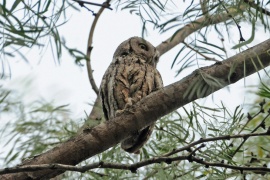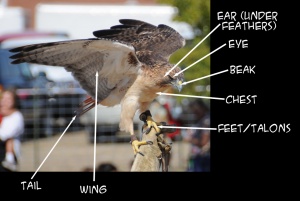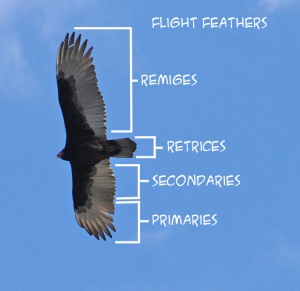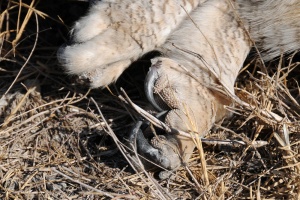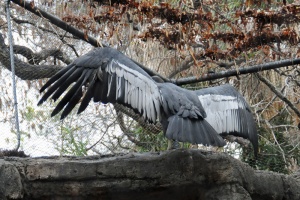Difference between revisions of "AY Honors/Raptors/Answer Key"
| Line 136: | Line 136: | ||
===c. kinds of nests do raptors build=== | ===c. kinds of nests do raptors build=== | ||
| + | |||
| + | As would be expected from such a diverse group, raptors build many different types of nests. | ||
| + | |||
| + | Some build large stick nests, among them the Bald Eagles, Osprey, Secretarybird, Crested Caracara, and Red-Shouldered Hawk. Osprey nests are usually atop a solitary pole, Caracara may place their nests atop a small tree or palm. | ||
| + | |||
| + | Others scrape out nesting sites on cliffs, such as the Peregrine Falcon, or the Merlin (which may also use old nests of other raptors). | ||
| + | |||
| + | Several types of owls nest in natural cavities in trees, including the Screech Owl, while the Elf Owl prefers to nest in old woodpecker holes in Cacti. The Common Kestrel is another cavity nester. | ||
| + | |||
| + | Most vultures do not bother building nests at all, laying their eggs in tall grasses, natural hollows in rocks or on cliffs, or in fallen hollow logs. | ||
| + | |||
| + | The Burrowing Owl, as its name suggests, prefers to nest in ground burrows, usually ones abandoned by mammals. | ||
| + | |||
| + | <gallery mode="packed-hover"> | ||
| + | Image:Pandion haliaetus 2.jpg|Osprey stick nest atop a pole | ||
| + | Image:Buteo lineatus 4.jpg|Red-Shouldered Hawk nest in the crook of a sycamore tree, two eyas (chicks) and mother in nest | ||
| + | Image:Bubo virginianus 2.jpg|Great Horned Owl nest atop a wall, with three owlets | ||
| + | </gallery> | ||
| + | |||
===d. the average life span for large and small raptors=== | ===d. the average life span for large and small raptors=== | ||
Revision as of 16:52, 24 April 2015
| This honor was introduced in 2015, but the patch for it is not yet available. Please do not request it from AdventSource until after Fall 2015. |
|---|
Raptors
Approval authority:
Category:
Skill Level:
Year of Introduction:
![]()
Contents
1. What does the word “raptor” mean?
The word Raptor comes from the Latin word rapere, meaning to seize, or snatch away. The term is used in reference with the way many raptors kill their prey with their feet.
Raptors include hawks, eagles, kites, vultures, condors, harriers, kestrels, falcons, owls and the secretarybird. Raptors are often referred to as birds of prey, as they are frequently active hunters (aside from the vultures and condors, which are primarily carrion eaters). A common characteristic among raptors are their sharp, curved talons for catching and holding prey, their curved upper bill for tearing flesh, and often their keen eyesight, hearing and/or sense of smell, used for finding their food.
2. Classification:
a. Identify the 2 major groups of raptors.
Raptors are divided into two broad groups, the diurnal raptors (those active in the day), such as hawks, eagles, kites, falcons and osprey, and the nocturnal raptors (those active at night), which comprise the typical owls and the barn owls.
b. List the scientific names of the orders & families collectively referred to as "raptors" or "birds of prey."
Raptors are currently divided into three Orders under the Class Aves:
Order Accipitriformes (accipiter, from the Latin word meaning hawk)
- Family Accipitridae: including the hawks, eagles, and kites, some 217 species worldwide
- Family Cathartidae (cathartes, from the Greek word meaning purifier): the seven species of vultures and condors
- Family Pandionidae (Pandion, from the Greek legend, the father of Procne, changed into a swallow): the two species of Osprey
- Family Sagittariidae (Sagittarius, Latin for archer): One species of Secretarybird
Order Falconiformes (likely from falx, from the Latin meaning sickle, referring to the curved beak)
- Family Falconidae: Some 60 species of falcons and their allies, including the Caracaras
Order Strigiformes (strix, from the Greek meaning to screech)
- Family Strigidae: Some 124 species of owls worldwide
- Family Tytonidae (Tyto, from the Greek for owl): The ten species of Barn Owls
c. Identify distinct characteristics of raptors.
d. an example of a raptor that illustrates each of the families represented under these two major groups (7 families).
Use this to find how many of each family are in your area, and then see of you can find them. Some examples include:
- Accipitridae: The largest and most diverse family of raptors. Includes the Bald Eagle, Red-Tailed Hawk, and Mississippi Kite, among others. Below are a small selection of raptors found in the Family Accipitridae.
- Cathartidae: There are seven recognized species in the Family Cathartidae: Turkey Vulture (Cathartes aura), Lesser Yellow-Headed Vulture (Cathartes burrovianus), Greater Yellow-Headed Vulture (Cathartes melambrotus), Black Vulture (Corygyps atratus), California Condor (Gymnogyps californianus), King Vulture (Sarcoramphus papa) and the massive Andean Condor (Vultur gryphus)
- Pandionidae: There are now two recognized species of Osprey (formerly there was only one recognized species): the more common Western Osprey (Pandion halietus), and the Easter Osprey (Pandion cristatus), which occurs between Sulawesi, Australia and New Caledonia.
- Sagittariidae: There is only one species in this family, the Secretarybird (Sagittarius serpentarius), found in Africa.
- Falconidae: Falconidae are divided into two sub-families, Falconinae and Polyborinae. The former has four genera, and includes the ubiquitous Peregrine Falcon (Falco peregrinus), the Merlin (Falco columbarius) and the American Kestrel (Falco sparvarius), as well as the tiny Black-Thighed Falconet (Microhierax fringillarius). The Polyborinae comprises seven genera, and includes the Crested Caracara (Caracara cheriway) and the Barred Forest Falcon (Micrastur ruficollis).
- Strigidae comprises some 27 genera of “typical” owls in three sub-families, and includes the massive Eurasian Eagle-Owl (Bubo bubo), the Great Grey Owl (Strix nebulosa), the tiny Northern Pygmy Owl (Glaucidium gnoma) and the equally diminutive Elf Owl (Micrathene whitneyi), and the Great Horned Owl (Bubo virginianus).
- Tytonidae is divided into two sub-families, each with just a single genus. Among the Tytonidae are the Oriental Bay Owl (Phodilus badius), the Common Barn Owl (Tyto alba), and the Australian Masked Owl (Tyto novaehollandiae).
3. From a diagram, identify or label the following parts of the raptor:
a. Eyes
b. Feet & Talons
c. Chest
d. Body
e. Beak
f. Ears
g. Wings
h. Feathers
The flight feathers in raptors are called Retrices on the tail, Remiges on the wings. The main feathers responsible for flight on the wings are divided into the Primary feathers (Primaries), the Secondary feathers (Secondaries), and at times Tertiary feathers.
The ears are usually hidden behind the feathers, and occur a little below and behind the eye. "Eared" owls, those with tufts sticking up on either side of the head, also have their ear in the normal place - the raised tufts are not related to the ear location.
The third picture above is a close up shot of owl talons. Note the sharp, curved claws, used for grasping prey.
4. Discover the following information about raptors. Use this information to compare and contrast raptors with another family of birds, such as ducks & geese (anatidae) or parrots (psittaciform).
a. the smallest diurnal and nocturnal raptor
The smallest diurnal raptors are the Black-Thighed Falconet and the White-Fronted Falconet, the former, found on peninsular Malaysia and southern Thailand, Borneo, Sumatra and Java, measures 14-17 centimeters (5.5-6.7 inches) and weighs 28-55 grams (0.06-0.12 pounds). The latter is found in northern Borneo, also measuring 14-17 centimeters (5.5-6.7 inches), weighing 35-65 grams (0.08-0.14 pounds).
The smallest diurnal raptor in the United States is the American Kestrel, which by comparison is a massive 22-31 centimeters (8.7-12.2 inches) long, and 80-165 grams (0.18-0.36 pounds).
The smallest nocturnal raptor is a toss-up (depending upon the individual specimen) between the Northern Pygmy Owl (at 16-18 centimeters/6.3-7.1 inches long), found through Central America, Mexico, the western United States to Canada, and the Elf Owl, living in the American southwest and south central states and Mexico, at 13-30 centimeters (5.1-11.8 inches) long, and weighing around 40 grams (0.09 pounds).
The Pygmy Parrots of New Guinea are the smallest parrots, measuring just 3.5-4 inches in length. The African Pygmy Goose, weighing in at just around six-tenths of a pound and measuring 12 inches in length, is the smallest of the waterfowl.
b. the largest diurnal and nocturnal raptor
The largest diurnal raptor by wingspan is the Andean Condor (image below), measuring in at 10 feet or more across. By weight, it is the California Condor, at 31 pounds.
The largest nocturnal raptor by weight is either the Eurasian Eagle-Owl, measuring 2-2.5 feet with a wingspan of 5-6 feet (weighing 3-9 pounds), or the endangered Blakiston’s Fish Owl, measuring 2-2.3 feet and weighing 6.5-10 pounds. By size (but not weight), the Great Grey Owl tops both, measuring 2-2.75 feet with a wingspan of up to five feet, but weighing in at only 1.3 to slightly over 4 pounds.
By comparison, the largest parrots, the Hyacinth Macaw, can reach a length of some 3.3 feet, and the flightless Kakapo can weigh up to 4.5 pounds, and the largest waterfowl are the Trumpeter Swan, with a 10 foot wingspan and weighing in at some 38 pounds.
c. kinds of nests do raptors build
As would be expected from such a diverse group, raptors build many different types of nests.
Some build large stick nests, among them the Bald Eagles, Osprey, Secretarybird, Crested Caracara, and Red-Shouldered Hawk. Osprey nests are usually atop a solitary pole, Caracara may place their nests atop a small tree or palm.
Others scrape out nesting sites on cliffs, such as the Peregrine Falcon, or the Merlin (which may also use old nests of other raptors).
Several types of owls nest in natural cavities in trees, including the Screech Owl, while the Elf Owl prefers to nest in old woodpecker holes in Cacti. The Common Kestrel is another cavity nester.
Most vultures do not bother building nests at all, laying their eggs in tall grasses, natural hollows in rocks or on cliffs, or in fallen hollow logs.
The Burrowing Owl, as its name suggests, prefers to nest in ground burrows, usually ones abandoned by mammals.
d. the average life span for large and small raptors
Among the raptors, a general rule is that the smaller the species, the shorter the lifespan. Small raptors live 3-15 yearts, thoug for nearly all raptors, the first 1-3 years are the most dangerous, and the time they are most likely to be killed prematurely. Larger raptors live 20-40 years, and perhaps even longer in captivity for some species.
Like the raptors, smaller parrots have shorter lifespans, perhaps some 15-20 years, while the larger species may live 80 or more years. For waterfowl, some geese may live well over 20 years, while other ducks may have shorter average lifespans, in the 8-20 year range.
e. the most common food of raptors
f. How do raptors eat their food?
5. Do one of the following:
a. watch a live raptor demonstration
b. Read a book on raptors
c. Watch a film documentary on raptors
6. Do two of the following:
a. Create a puppet show about raptors
b. Dissect an Owl Pellet, preferably online, and write down what you find
c. Make a chart of raptor wing spans and shapes of wings
d. Make a file of at least 10 raptor craft ideas and complete 5 of the crafts.
e. Make a notebook, art display, media presentation or collage with pictures and information about raptors
f. Create a board game about raptors
g. Photograph at least 5 live raptors in the wild or captivity. Label your photographs.
7. Experience raptors in one of the following ways
a. Visit a zoo or aviary. Have a docent tell you about the raptors they care for.
8. Observe raptors in the wild nesting or migrating. If possible, work with an area nature center, park, or Wildlife Management Areas.
9. Find two Bible passages about raptors and summarize a moral lesson from each one.
There are many mentions of raptors in the Bible. Practice using a concordance in your search (something you need to do for Explorer class Investiture Achievement). Depending upon the version, there may be different translated names, but in general you will be able to find eagle, owl, falcon, kite, osprey, and vulture.
Eagles generally denote speed, power, strength and might, as well as something largely unreachable and untamable.
- God is represented as a powerful eagle, as protecting his people or carrying them out of trouble (Ex. 19:4, Deut. 32:11, Rev. 12:14, Ezek. 7:1-10)
- The eagle may be a symbol of strength, youth and revival (Ps. 105:3, Is. 40:28-31)
- Just as the eagle can be seen as powerful for good, it can also represent the power of destruction, often as either a tool of God’s wrath, or as a the power of an overwhelming enemy (Deut. 28:49, Jer. 4:13, Jer. 48:40, Jer. 49:22, Lam. 4:19, Hos. 8:1, Hab. 1:8)
- Eagles are fast, and are used as a comparison to speed, or to things being snatched away or fleeting (2 Sam. 1:23, Job 9:26, Prov. 23:5)
- The soaring height of eagles and their nests hidden in high rocky crags represents distance - a distance that is easily overcome by God (Jer. 49:16, Ob. 1:4)
- Finally, eagles are often seen in the characteristics of heavenly beings (Ez. 1:10, Dan. 7:4, Rev. 4:7, Rev. 8:13)
- Owls represent something that lives in desolate places, in places without people. They are a symbol of complete destruction, or of severe loneliness (Job 30:29, Ps. 102:6, Is. 13:21, Is. 14:23, Is. 34:8-15, Jer. 50:39, Zeph. 2:14)
There are other examples of raptors in the Bible, sometimes just as themselves (as in the discussions of clean and unclean animals in Leviticus and Deuteronomy), at other times based on their characteristics (falcons with strong sight, vultures gathering around a corpse).

















